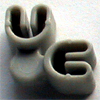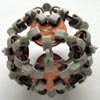 Coinstruction
Coinstruction
 Coinstruction
Coinstruction
Coinstruction is a toy made by Educational Insights that consists of 6 different types of connectors that are used to attach coins to each other. Though they will fit many kinds of coins, US pennies appear to be the most common coin used.
Kids at heart. Bio-Chem majors. Parents who want to help build their children's spatial intelligence.
So what? I mean, what can I do with these?
You can make various shapes and designs in 2 and 3 dimensions. It's hard to explain, but they're really fun to play with. Look below to see a few example things i've made.
Can I get the plans for the Robot/SpaceShuttle/Dragon from John Perkins?
At the moment I (John Perkins) am unsure as to the copyright status of the plans included with various Coinstruction sets. I think freely distributing the various sets of plans would only serve to increase sales of Coinstruction, thus benefitting Educational Insights (the manufacturer). The problem is that I have not yet succeeded in contacting them, so I don't know how they feel about it. On the one hand they might be fairly casual about it- 'Make copies, distribute the plans, fine with us.' On the other hand they might be real defensive- 'Our copyright. You distribute, we sue.' If I get permission from them, I will post the plans here.
An update... I haven't succeeded in contacting Educational Insights, but I have received my first request for plans. No, that's not entirely true. I received my first request for plans at a time when I have a working scanner. I don't foresee any problems- i'm advertising their product for them in a positive manner, free of charge.
What are the 6 different kinds of pieces?
These are the names I use for the 6 kinds:
"I" pieces. Connect 2 coins in a straight line (180 degree angle).
"L" pieces. Connect 2 coins at a 90 degree angle.
"T" pieces. Connect 3 coins in a T shape with angles of 90/90/180 degrees.
"V" pieces. Connect 2 coins at a 120 degree angle. However, due to manufacturing issues, most sets contain pieces at a 240 degree angle.
"X" pieces. Connect 4 coins at 90 degree angles.
"Y" pieces. Connect 3 coins at 120 degree angles.
I know of 4 places:
Manufacturer:
Educational Insights. Buy it directly from them. The advantage here is that you can probably order from them no matter where in the world you live. This disadvantage is that they appear to have not updated their web site in months, so placing an order or contacting an actual human being may be difficult.
Educational / Toy Stores.
What you're looking for here is a toy store or 'learning store' that carries mainly educational stuff. Not something like 'Toys R Us;' something like 'The Knowledge Store.' You can tell the difference (in types of store) by the type of toys they carry.
I've seen Coinstruction at 3 stores in southern California.
The first of these I don't remember the name of, but it's in the mall in Claremont just off the 10 freeway. It's something like 'The Knowledge Store' or 'The Learning Store,' but it's definitely the only specifically educational toy store in the mall.
The second store is World Discoveries in Redlands, CA.
World Discoveries' web site. You can order Coinstruction from their site. Under "Shop By Category," click on "building toys."
Driving Directions. From anywhere to their store in Redlands. Yahoo Map.
Show me a picture. Image of the shopping center in Redlands where World Discoveries is.
Ebay.
The online auction site. Yes, I was and still am nervous about sending my money to someone before I get the product. I have made 4 purchases from Ebay so far and have yet to have trouble, so the system seems to work well. The advantage here is that you can get stuff at a very good price. I bought 2 of the boxes that would have cost $35 each at the mall for $5 each.
Show me some of the things you can make with Coinstruction.
(click on any of the pictures in this section to see a larger version)
A triangle of pennies.
An "H" shape made out of T pieces.
An "X" shape made out of L pieces.
 Coinstruction Hexagon Assembly
Coinstruction Hexagon Assembly
Assembly: Hexagon Triangle
First, we make a hexagon using Y pieces.
Next, using one edge of the hexagon you just made, start another hexagon attached to the first.
Looking at the picture, what you're doing is adding the shape in the lower right corner. You may find it easier to add the pieces to the existing hexagon one by one, rather than making the shape in the lower right corner of the picture separately first.
Next, add the top part of the triangle to the 2 hexagons you have so far.
Looking at the picture, you're attaching the shape at the top to the double-hexagon you made.
You did it!
Now try building more hexagons off this shape. Hexagons fill space perfectly; that is, they tesselate. What that means is as long as your supply of Coinstruction pieces and pennies doesn't run out, you can make this thing as big as you want.
 Coinstruction Assembly V-Ball
Coinstruction Assembly V-Ball 
First, make a triangle of coins using V pieces.
The big thing to remember here is to have the V pieces always curving in on the shape, like a ball.
Next, choose one of the coins and build around that until you have the 'middle' coin with a pentagon (5 coins) around it.
(this is the same shape you have right now, from a different angle)
The shape you end up with from the above step is very similar to the hexagon using I pieces, accept there's 5 coins around the middle coin and you're using V pieces instead of I pieces.
Next, on top of the 5 outer coins, add another layer of coins.
This will also take 5 coins. When you've done that, the 'ball' shape will be easy to see.
Next, add the final coin to the top, completing the ball.
You did it!
This is the hardest shape to make from this web site, mainly because all of the other shapes are flat. They don't bend up off the surface of the table. For most people this is the hardest shape to visualize.
About the mathematics of this shape. This is not a correct shape. What does that mean? In the triangle shape (the one made with I pieces), for instance, the thing you make with Coinstruction has angles that add up to 180 degrees, just like a triangle drawn on a (flat) piece of paper. The angles in the ball shape here do not add up properly. The reason it's possible to make this shape with Coinstruction is the plastic pieces bend a tiny bit, just enough of a 'fudge factor' to make it (the ball) work.
 Coinstruction Large Hexagon Assembly
Coinstruction Large Hexagon Assembly
First thing is to make a triangle using I pieces.
Next, add more coins going around the middle coin...
... until you have one coin in the middle surrounded by 6 coins.
Next, start adding another layer of coins around the outside.
You did it!
What you end up with is a single coin in the middle surrounded by 2 layers of hexagons. Hexagons fill space perfectly; that is, they tesselate. What that means is as long as your supply of Coinstruction pieces and pennies doesn't run out, you can make this thing as big as you want.
This one has 8 layers of hexagons. I didn't have enough pieces to make a 9th layer.
Email: John Perkins if you have any questions!